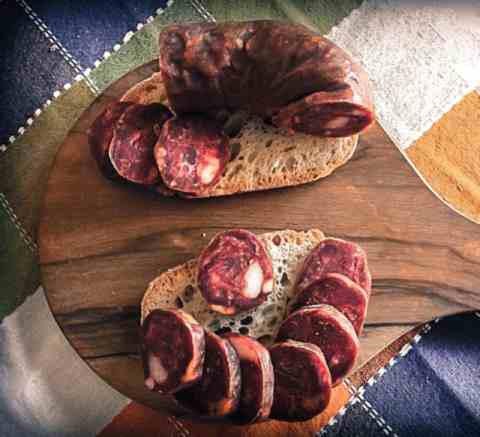Maratea's Sausage
MARATEA. " 'u zazicchiu "
Talking about Maratea's gastronomy means first of all not to forget about the sausage goddess.
The Roman historian, Varrone, referring to the sausages, writes: "They call lucanica a minced meat, stuffed in a gut, because our soldiers learned how to prepare it from the Lucani."
The same Apicius, in his important "De re coquinaria" describes the recipe; So since Roman times "lucanica or lucanega" is synonymous with sausage

'u porcu [THE PORK]
In Maratea the slaughter of the pig was and still is a holiday occasion, which lasted for three days or more, with friends and relatives invited to live this important moment of sociality and well-being.
It is said that the pig does not throw anything but the sausages remain the main products of slaughter.
Sausages produced in Maratea (almost always only for family use) are of high quality and can be eaten fresh or seasoned ("cured") or stored under oil or sugar.
The suppressed pork sausages cut with the tip of the knife, dried and then stored in extra virgin olive oil, represent the other splendid relics of the slaughter of the pig.
The "lucaniche"
To know the origin of the Lucanic name it is useful to have learned Latin (no scary: it is immediately translation) and read Varrone, The Latin language, V, 111:
Quod fartum intestinum crassundiis, Lucan <i> am dicunt, quod milites to Lucanis didicerint.
[Text taken from the edition by R.G. Kent, Varro. On the Latin Language, I, Books V.-VII, Cambridge (Mass.) - London 1938]
Translation: A type of sausage made with the large pig's intestine is called a Lucanic, because our soldiers have learned to do it from Lucani.
It follows that Lucania is the home of sausage - derived from salt and meat, used to make it.
Other Latin writers speak of Lucan slaves who had brought the novelty to Rome ... probably the truth is that lucanica is the pork or mutton bud (lucanega) used to sack the minced meat of the pig.
TO KNOW MORE ABOUT MARATEA'S SAUSAGE
www.maratea.info is managed by
AltriTurismi ets Association
-
Support our Association MAKE A DONATION !



